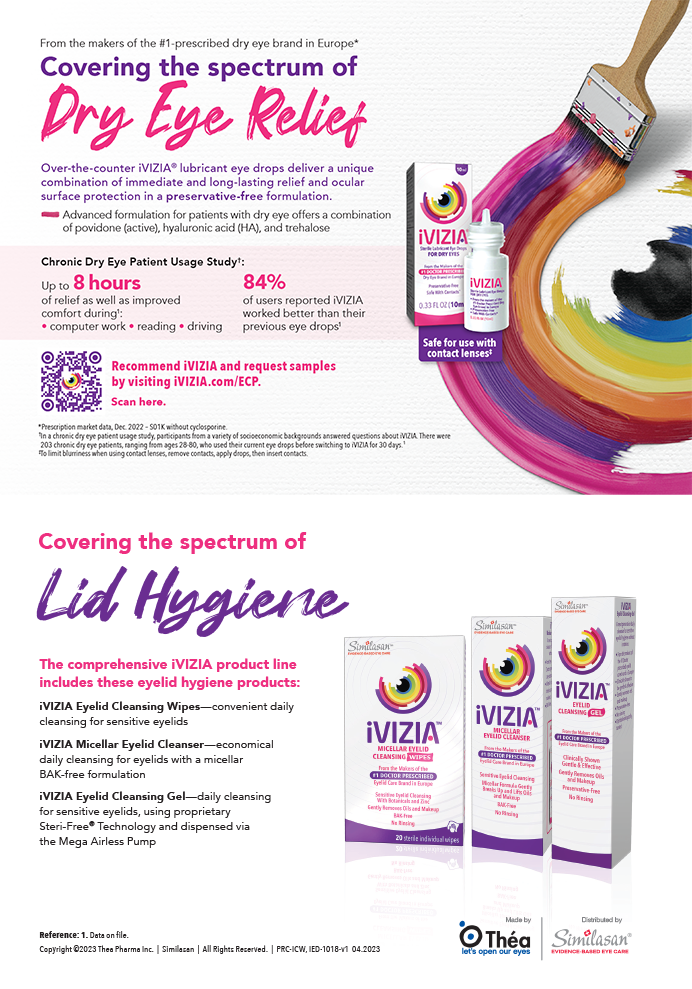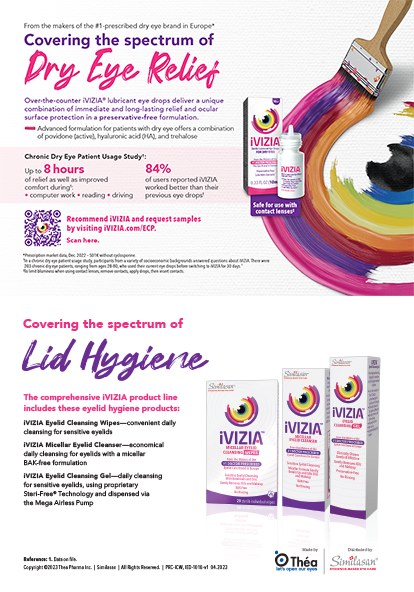
Sterile allograft corneal inlays have emerged as a promising solution to hyperopia and presbyopia. They could offer superior visual outcomes and corneal tissue preservation compared to traditional treatments such as monovision for presbyopia, which increases the depth of focus, or clear lens extraction for hyperopia, which retains natural accommodation. Unlike procedures such as epikeratophakia that alter the corneal shape with unpredictable results, allograft corneal inlays are strategically placed beneath a LASIK flap or within a corneal pocket. Both permit sutureless application, removal, and power adjustment.
Allograft corneal inlays are being used for presbyopia and hyperopia treatment. The approach of adding tissue rather than removing it, combined with the benefits of reversibility, exchangeability, and precise laser shaping, sets this technique apart from traditional refractive surgeries. Synthetic corneal inlays have shown some promise, but their widespread use has been limited by biocompatibility issues. This article delves into the potential that allograft corneal inlays hold for optimizing refractive correction and enhancing visual outcomes.
CUTTING-EDGE TECHNOLOGY
Donor tissue. Allograft corneal inlays are derived from human corneal tissue. The tissue is responsibly sourced from accredited eye banks, ensuring rigorous adherence to strict ethical standards. The procurement method involves thorough screening processes in line with FDA regulations. Although the donor corneas may not be suitable for fresh tissue transplantation because of a low endothelial cell count or other factors, they are considered safe for corneal inlay transplantation. After undergoing processing and e-beam sterilization, the corneal lenticules are stored and dispatched at room temperature, prioritizing safety and minimizing the risk of disease transmission.
Laser processing. Corneal lenticules are formed at a tissue-processing facility. Corneal buttons are shaped with an industrial-grade excimer laser and monitored with high-resolution OCT to ensure accurate formation of the lenticule. The tissue is then packaged, stored in recombinant albumin solution, and submitted to e-beam sterilization to make them safe and suitable for ophthalmic application.
Hyperopia lenticules. The shape of the inlays is derived from precise calculations based on the refraction and higher-order aberrations. The wavefront-optimized lenticule profiles can correct hyperopia with a large optical zone and a smooth transition that surpasses those achieved with traditional laser ablation profiles. The physical diameter of the hyperopic lenticules is 6 mm, and the targeted optical zone is 6.5 mm. The thickness of hyperopic lenticules varies depending on the planned refractive correction. As with laser ablation, each 1.00 D increment increases central thickness by about 15 µm.
Presbyopia lenticules. A flap is created with a femtosecond laser, and the lenticule is positioned directly on the recipient stromal bed. After laser sculpting, the diameter of the inlay is 3 mm, and its central thickness is approximately 20 µm. By introducing optical aberrations and enhancing corneal asphericity, the inlay can improve depth of focus similarly to an extended depth of focus IOL.
Surgical procedure. A flap is created with state-of-the-art femtosecond laser technology. The stromal interface is cleaned. Next, the corneal inlay is carefully positioned on the stromal bed, and the quality of the lenticule is inspected. The flap is then replaced. Postoperative care helps ensure proper alignment of the inlay and protection of the cornea throughout the healing process.
EFFICACY
Hyperopia correction. A prospective feasibility study at Medipole University in Istanbul, Turkey, evaluated the safety, efficacy, and predictability of sterile allograft corneal inlays for the correction of hyperopia.1 The refractive power of each inlay was customized to address the patient’s refractive error. The inlays were placed under a LASIK flap, ensuring precise centration on the pupillary axis. Follow-up examinations at 6 and 12 months found substantial improvements in patients’ visual acuity and refractive outcomes. There were no significant postoperative complications (eg, diffuse lamellar keratitis, epithelial ingrowth, or decentralization).
The study also evaluated changes in corneal density following allograft corneal inlay implantation for hyperopia correction. Anterior corneal density and total corneal density were measured with a rotating Scheimpflug system (Pentacam, Oculus Optikgeräte) preoperatively and at 1, 3, 6, 12, and 36 months postoperatively. The measurements were taken at different concentric radial zones surrounding the corneal apex. At 12 months, the average anterior corneal density values had returned to baseline. Corneas remained clear without changes in corneal density for up to 36 months. Significant statistical differences in measurements were noted between 1 and 6 months, but the differences were deemed clinically insignificant. The investigators concluded that treatment effectively corrected hyperopia while maintaining corneal density within physiologic ranges during long-term follow-up.
Presbyopia correction. A prospective, single-armed, nonrandomized, multicenter clinical trial evaluated the effectiveness of allograft corneal lenticule implantation for presbyopia correction.2 The study enrolled 101 adults with presbyopia. A significant improvement in patients’ uncorrected near visual acuity was observed at 6 months.
The procedure’s safety profile was comparable to that of femtosecond LASIK and SMILE. Adverse events included two instances of diffuse lamellar keratitis, one of which required a flap lift and irrigation, and three cases in which explantation was performed owing to patient dissatisfaction.
A 3-year, single-site follow-up study evaluated 26 patients with presbyopia (52 eyes) from a subcohort who received allogenic corneal inlays in a multicenter study (unpublished data, Medipol University, Istanbul, Turkey). Investigators compared the defocus curves of treated versus fellow eyes and assessed the depth of focus achieved with the inlays. Patients experienced a significant improvement in near visual acuity and an increase in depth of focus in the eye that received an allogenic corneal inlay.
Changes in corneal density following implantation for presbyopia correction were assessed in a cohort of 47 patients (47 eyes) over a 36-month follow-up period. Using Scheimpflug tomography, measurements of the anterior corneal density were conducted over annular diameters in zone 1 (0–2 mm) and zone 2 (2–6 mm). These measurements were obtained at baseline and then again at 1, 3, 6, and 36 months postoperatively. The results demonstrated a significant but marginal increase in the mean baseline densitometry values for zones 1 and 2 at the 1-month follow-up visit, reaching a peak at the 3-month follow-up visit (zone 1: 24.34 ±3.79, P < .001; zone 2: 19.31 ±2.10, P < .001). From the 3- to 6-month postoperative period, the density values decreased significantly, reverting to baseline and demonstrating no meaningful change compared to preoperative values up to the 36-month follow-up. This suggests no long-term effect on corneal density after the implantation of allograft corneal inlays for presbyopia correction, with no long-term changes observed in corneal density. Further studies are necessary to elucidate the clinical significance and potential implications of the temporary fluctuations.
COMPLICATIONS AND MANAGEMENT
Decentration. It is important to adhere to simple procedures to position the lenticule accurately. A Marshall loop (Allotex) aids the process. Inlay positioning must be carefully assessed both during and after placement to ensure proper alignment with the center of the pupil. Suspected decentration should be addressed promptly.
Comprehensive postoperative assessments of inlay centration involve imaging modalities such as OCT, corneal topography, and wavefront analysis. Measurements obtained immediately after implantation are crucial to confirm inlay centration before surgery concludes. Repositioning is the corrective measure of choice for a significantly decentered inlay. Clinical trials reported no decentration when this postoperative quality control was employed, and no lenticule movement was observed at follow-up visits.3
Tear dysfunction. In nearly all patients, symptoms of tear dysfunction resembling those that appear after LASIK were reported and subsequently resolved in the majority of cases. Neural changes in the cornea and neuropathic causes of ocular surface discomfort may independently or synergistically contribute to symptom development. The key to minimizing the impact on surgical outcomes is appropriate management, which entails optimizing ocular surface health both before and after the procedure. No severe or persistent symptoms have been reported.
Flap-related complications. There are intrinsic risks associated with the creation of a corneal flap in LASIK surgery. These include flap dislocation, epithelial ingrowth (characterized by epithelial cells growing beneath the flap), and flap striae. Recommended treatments include repositioning or relifting the flap, removing ingrown cells, and smoothing out wrinkles to optimize visual outcomes. I have not encountered any of these complications in combination with allograft corneal inlays within my cohort of 150 eyes, including 28 hyperopic eyes. Additionally, clinically significant epithelial ingrowth, even after treatment for high hyperopia, has not been observed.
Under- and overcorrection of refractive errors. Under- and overcorrection of refractive errors can occur with allograft corneal inlays. Additional procedures may be considered in either situation to fine-tune vision. Laser ablation retreatment of a hyperopia lenticule could be considered to address residual refractive errors. This has not been necessary in my clinical trial experience.
WHAT DOES THE FUTURE HOLD?
The future of tissue addition technology using sterile allograft corneal stroma is promising. There are several potential applications within vision correction. Allograft corneal inlays have been successfully used to treat presbyopia, hyperopia, myopia, and astigmatism. Future advances may refine inlay design, possibly enhancing visual outcomes and increasing patient satisfaction.
Sterile allograft tissue addition technology may also have a role to play in keratoconus management and myopia control. Customized inlays could be used to alter the shape of the cornea and halt disease progression, with the potential for a subsequent CXL procedure after 6 months.
1. Tanriverdi C, Ozpinar A, Haciagaoglu S, Kilic A. Sterile excimer laser shaped allograft corneal inlay for hyperopia: one-year clinical results in 28 eyes. Curr Eye Res. 2021;46(5):630-637.
2. Safety and efficacy of an intrastromal transform corneal allograft (TCA) for presbyopia correction. ClinicalTrials.gov identifier: NCT03671135. Updated March 10, 2020. Accessed July 7, 2023. https://clinicaltrials.gov/ct2/show/NCT03671135
3. Kilic A, Tabakci BN, Ozbek M, Muller D, Mrochen M. Excimer laser shaped allograft corneal inlays for presbyopia: initial clinical results of a pilot study. J Clin Exp Ophthalmol. 2019;10(4).




